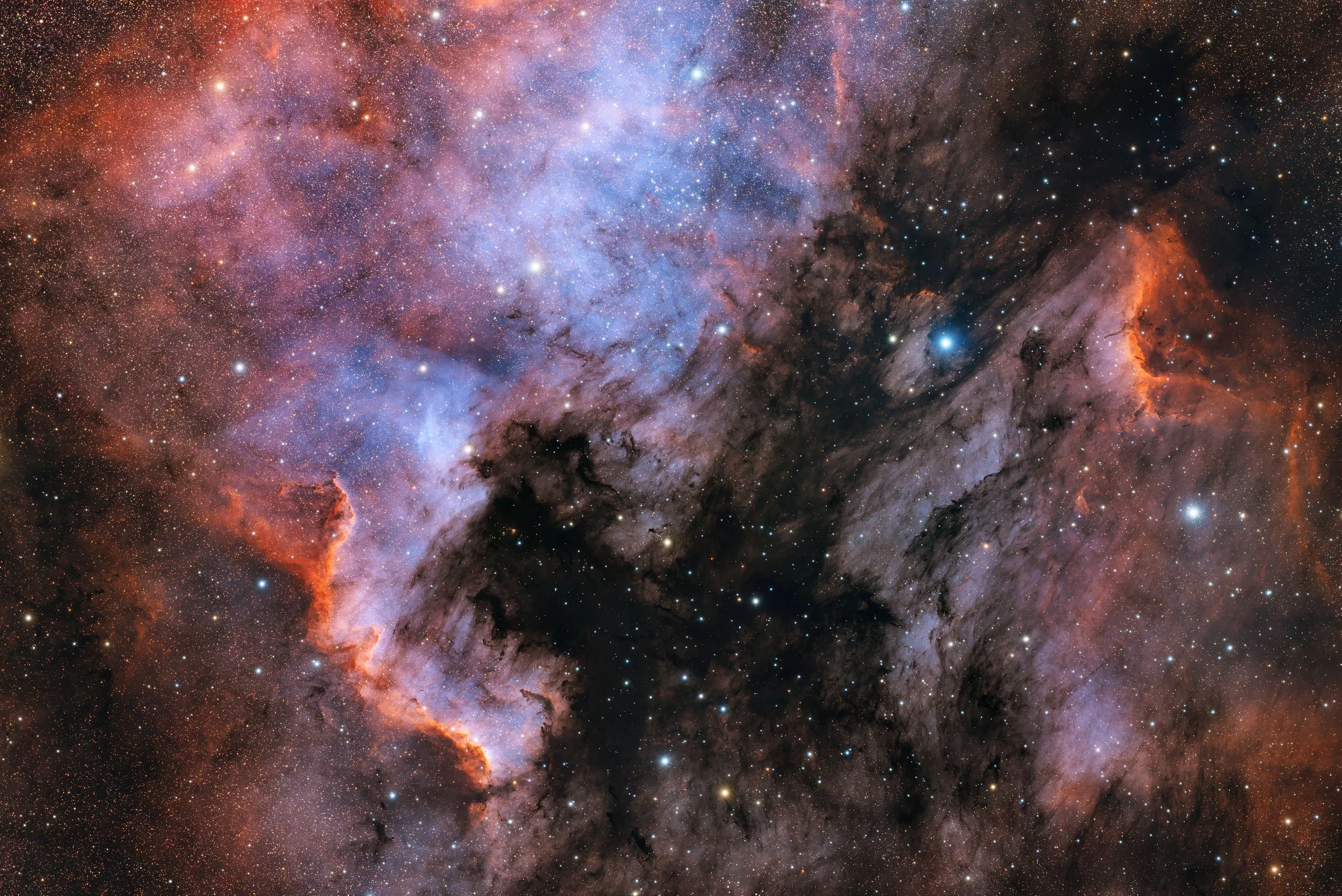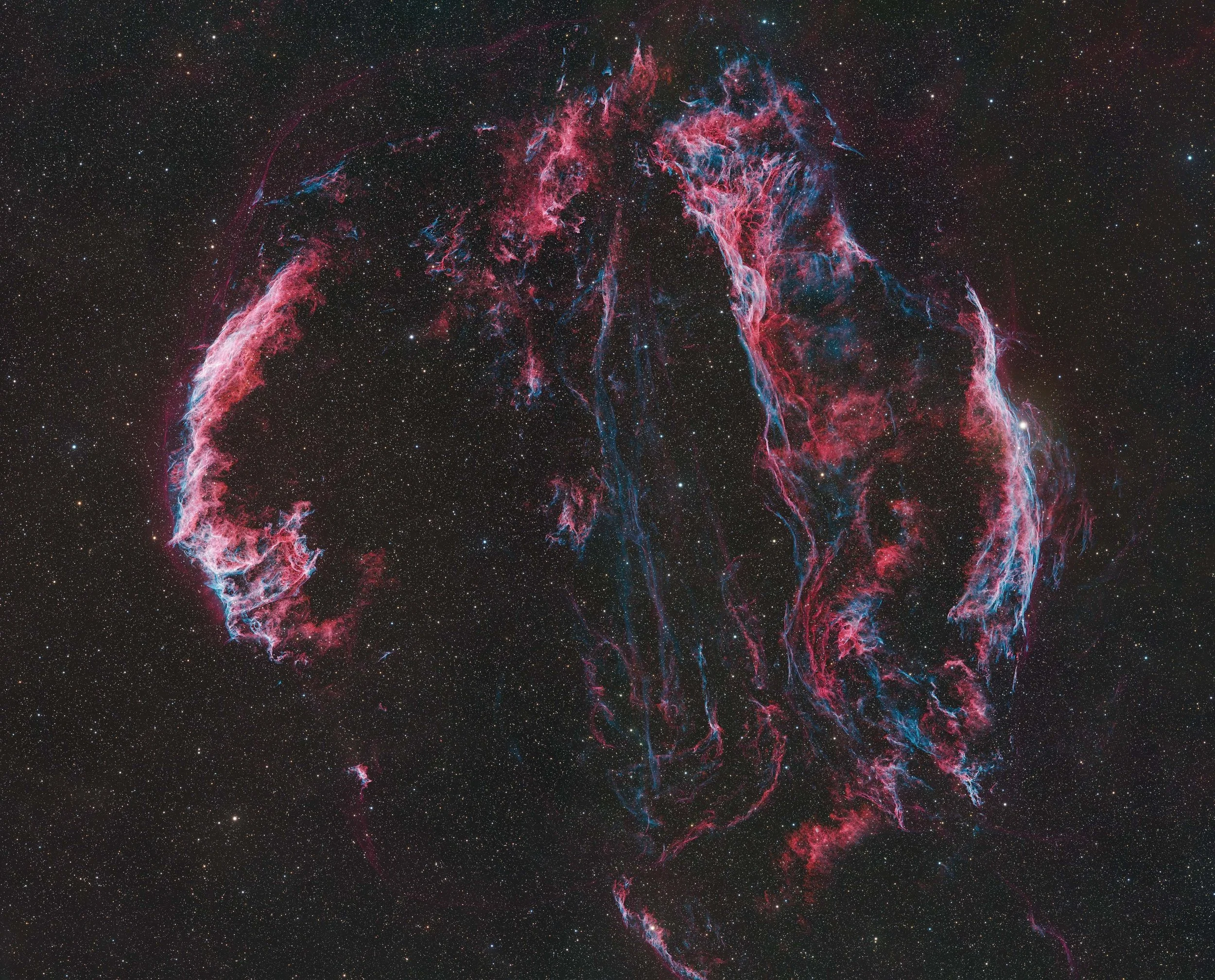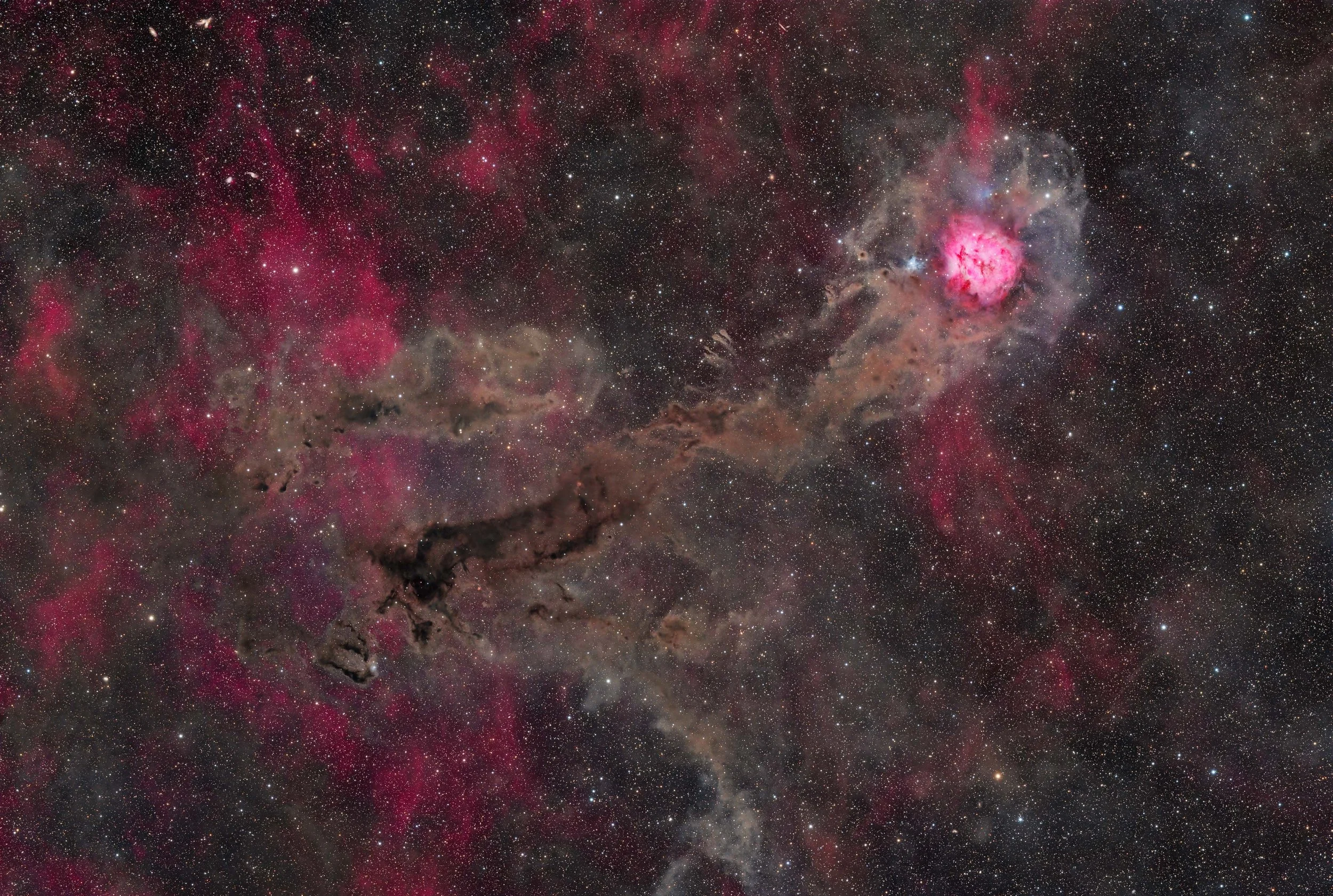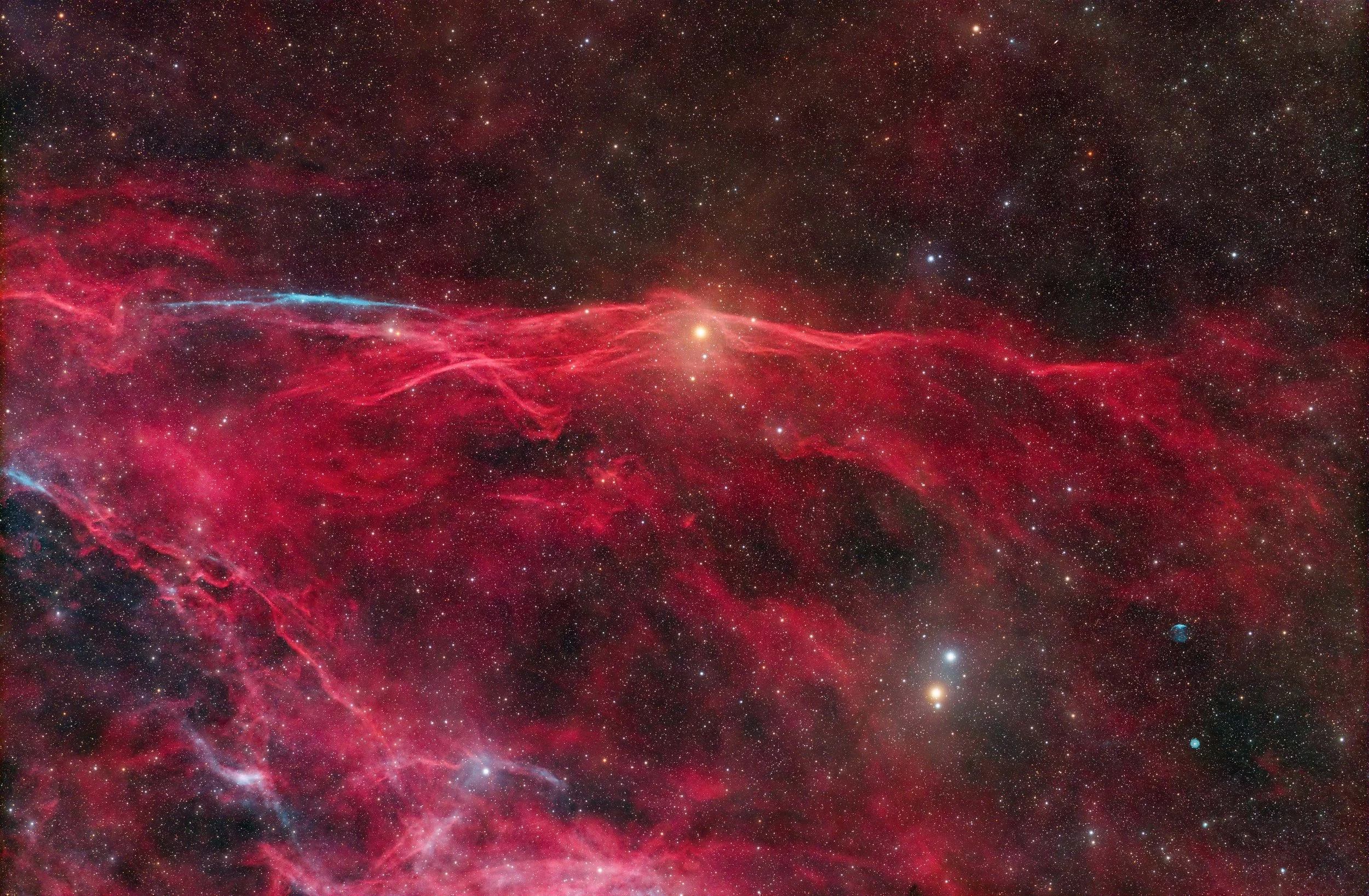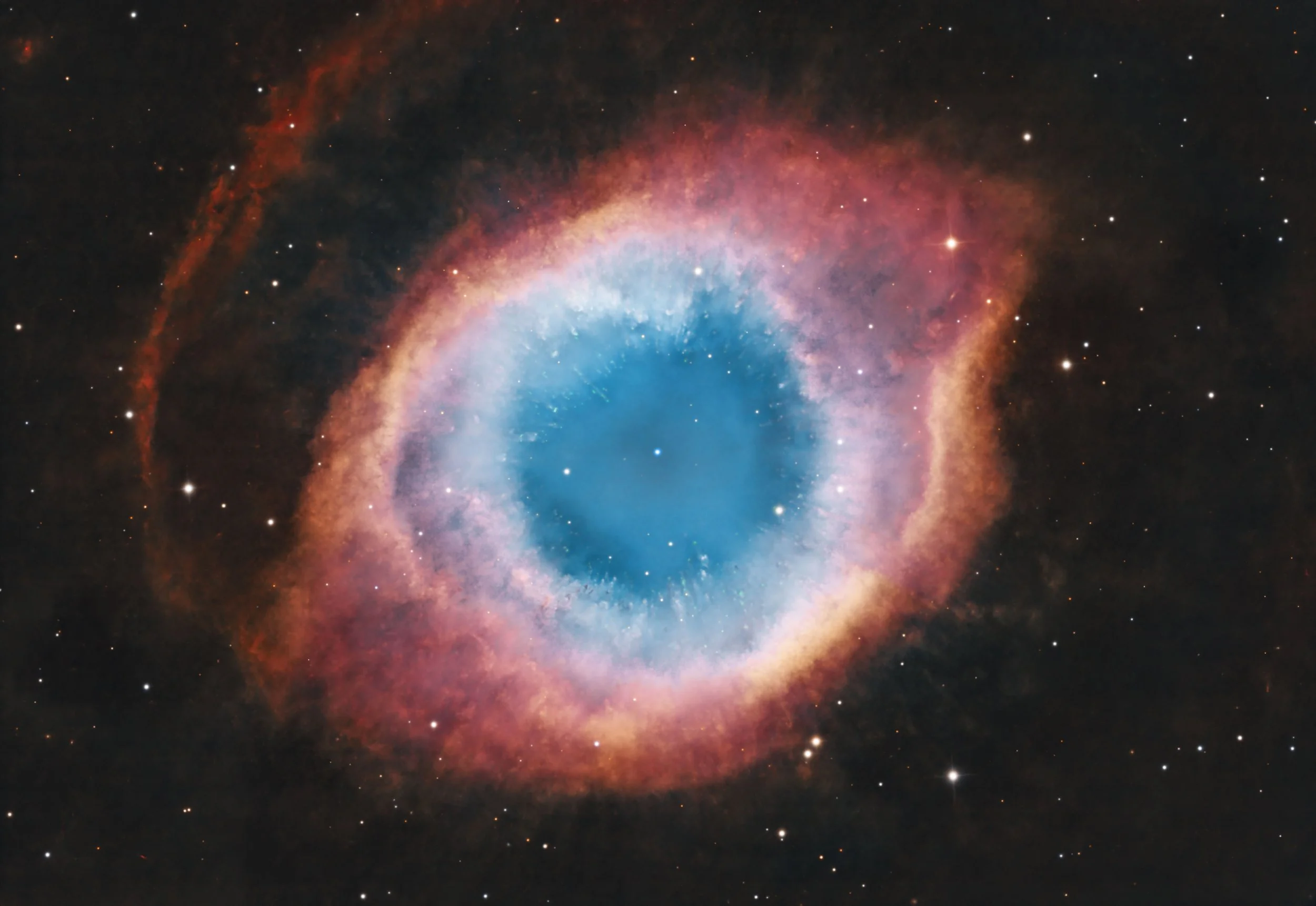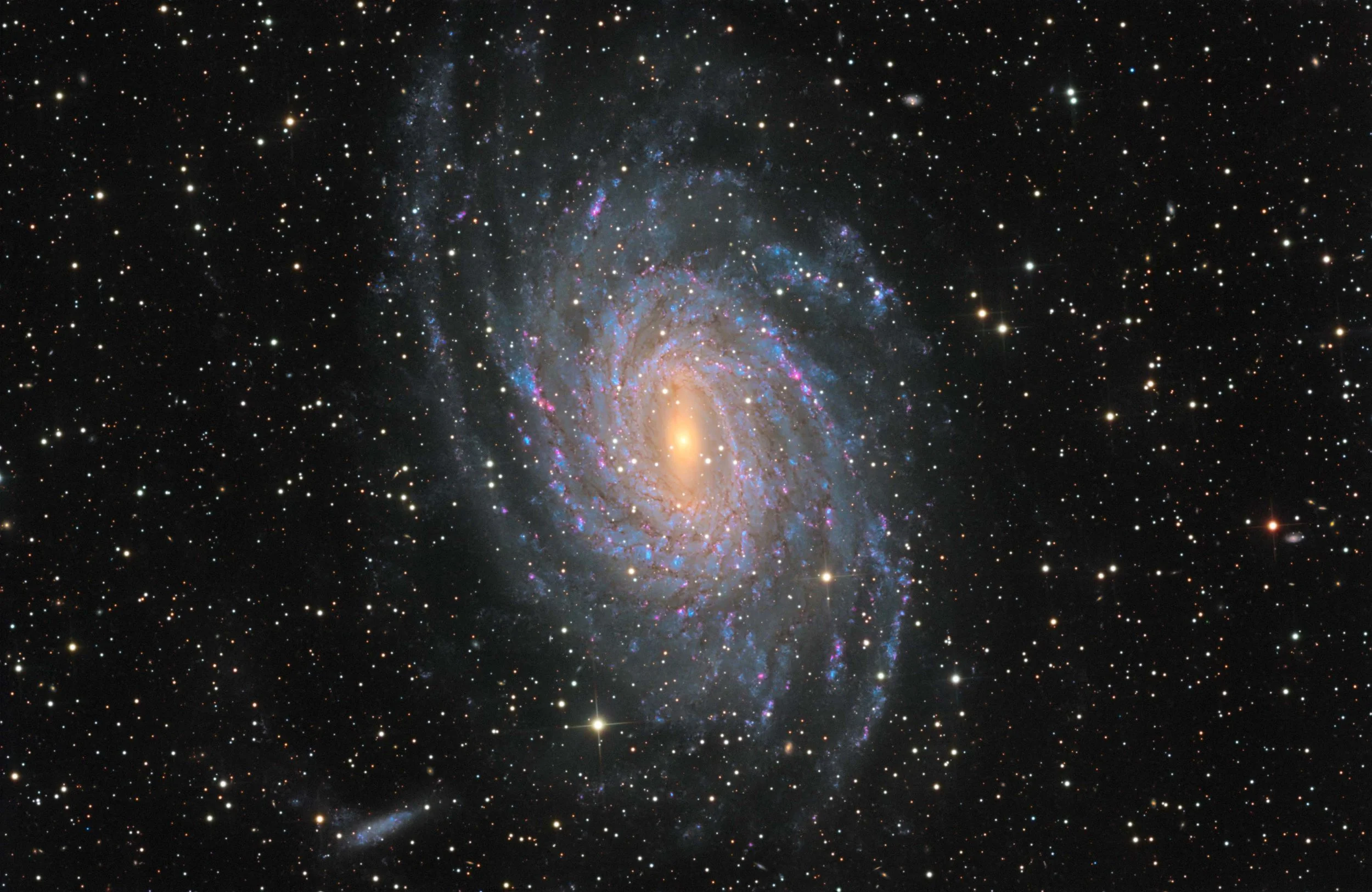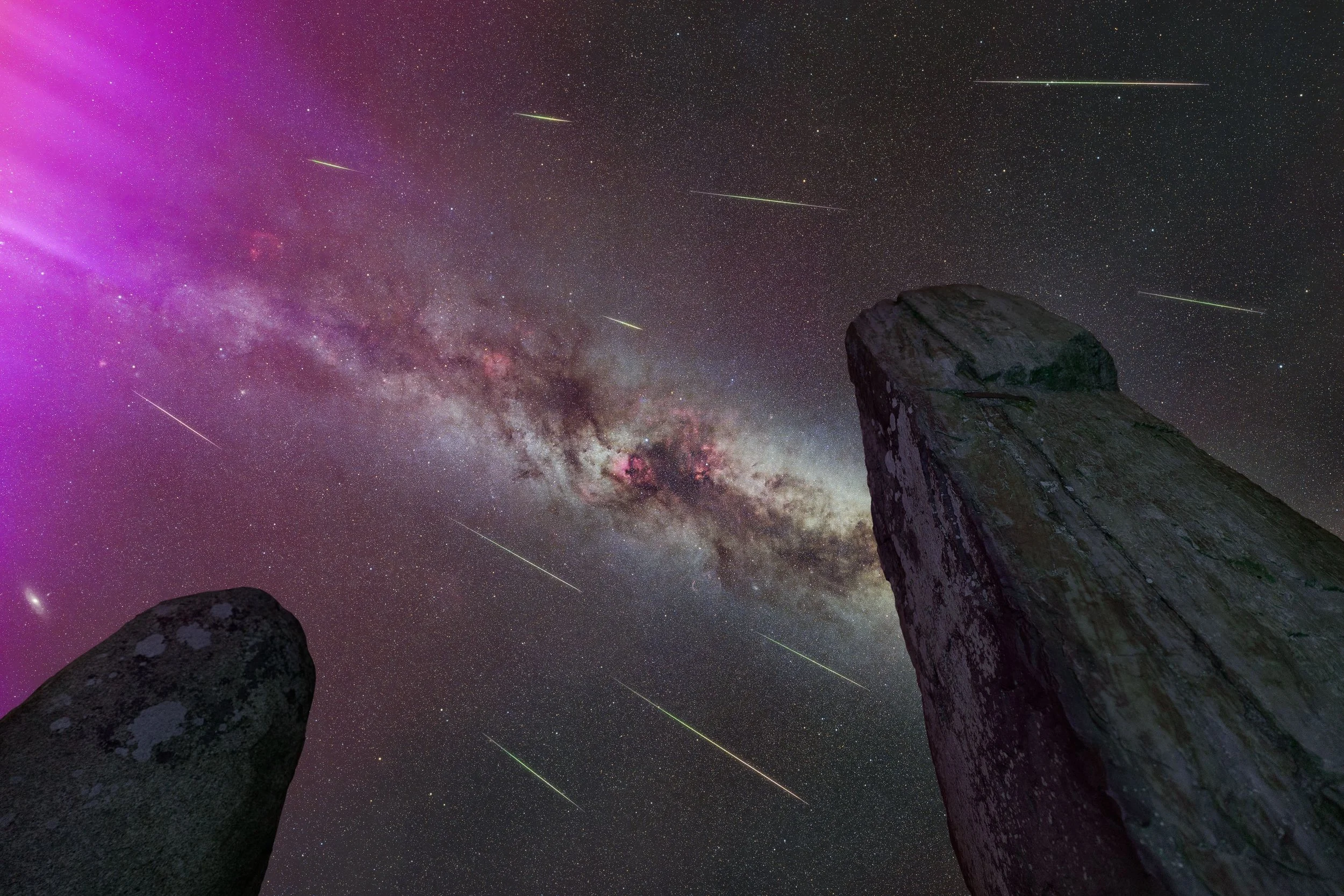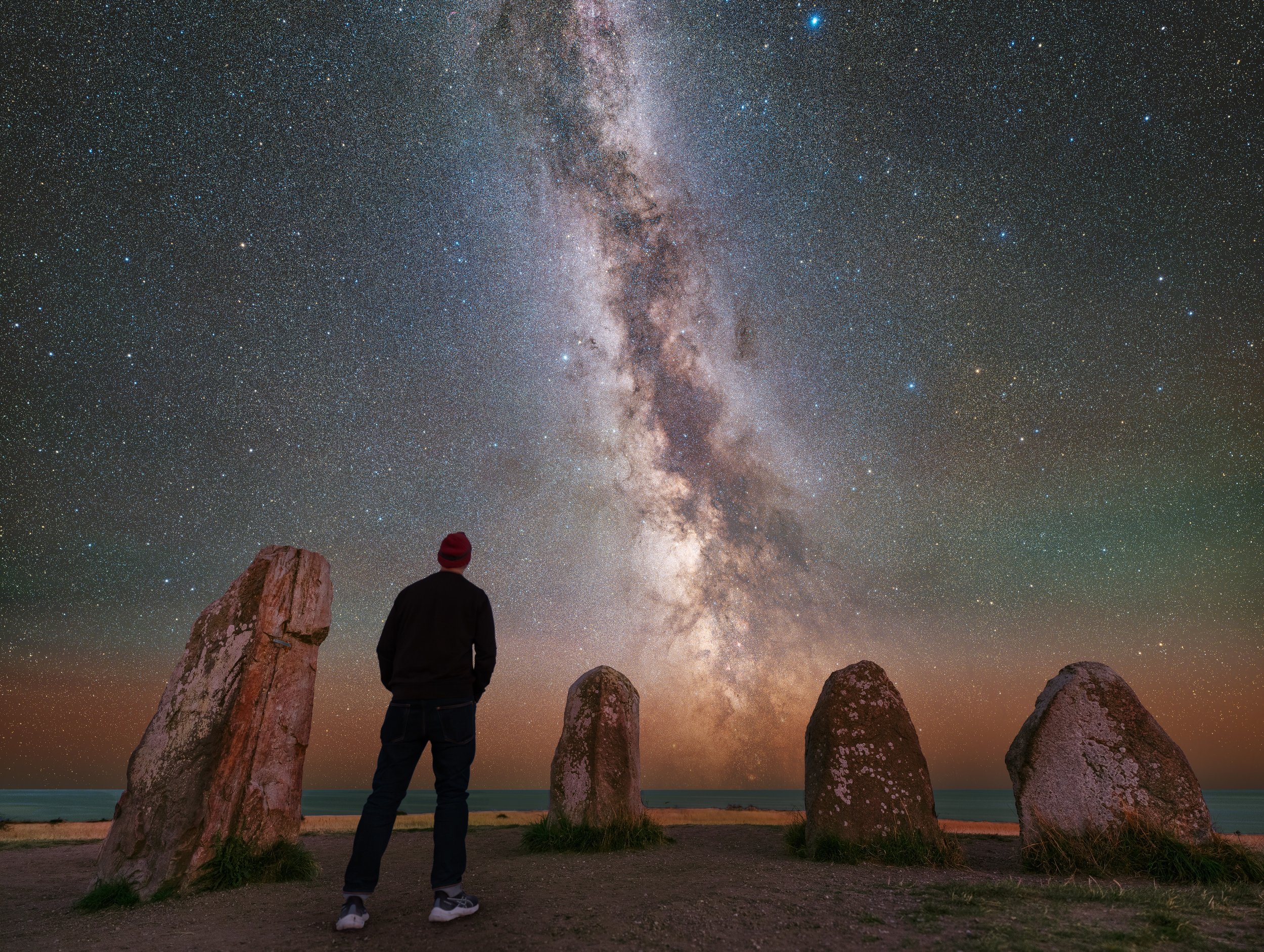
AUGUST 2025
When the Sky Overflows.
August is one of the richest months for deep-sky imaging — especially in the north.
At midnight, the Milky Way stretches straight overhead, placing its densest and most vibrant regions in perfect position. Emission nebulae, reflection clouds, and intricate dust structures light up the sky, packed into fields so dense it’s hard to know where one target ends and the next begins. This is peak season for widefield imaging, but zooming in is just as rewarding.
In the south, a quiet transition is underway. The Milky Way still dominates early in the night, but slowly dips westward as the evening progresses. In its place, another kind of treasure emerges — the beginning of the southern galaxy season, offering a different kind of depth and contrast.
Whether you’re aiming wide or going deep, August is a time when the sky doesn’t hold back. It’s a month that invites long exposures, bold experiments, and the joy of simply seeing what’s out there.
Deep-Sky Targets in August
August is peak season for nebulae in the northern hemisphere. The densest part of the Milky Way crosses straight overhead at midnight, filling the sky with bright emission regions, reflective dust clouds, dark lanes, and star fields so rich they barely leave room to breathe.
This month’s targets include iconic favourites like the Crescent Nebula and the Dumbbell — but also lesser-known objects tucked deeper in the galactic web. There’s a strong focus on narrowband-rich regions in Cygnus, plus some bold visual contrasts like the Helix and deep southern spirals.
Whether you’re shooting widefield with a DSLR, using a smart telescope, or building deep integrations with a mono rig, August offers something to match. Some targets are ideal for quick captures under limited skies; others reward long sessions and experimental palettes.
Below, you’ll find a visual overview and key info for each target.
For full framing advice, exposure tips, and filtration suggestions, download this month’s Cosmic Astrophotography Planner (CAP) as a free PDF using the button below.
NGC 7000 – The North America Nebula
Constellation: Cygnus | Distance: ~2,590 light-years | Apparent Size: 120′ × 100′ | Apparent Magnitude: ~4.0
NGC 7000 is a vast emission nebula whose shape strikingly resembles the North American continent — with the “Gulf of Mexico” region particularly well defined. The bright, sculpted arc known as the Cygnus Wall marks a region of intense star formation, where dark dust lanes cut into glowing H-alpha gas.
This is a perfect target for widefield imaging. A field of view between 2° and 4° works well to capture both the North America Nebula and the nearby Pelican Nebula (IC 5070), separated only by a dense interstellar dust band. Narrowband filters reveal rich structure and contrast, while broadband imaging is also possible under dark skies. It’s a great subject for experimenting with color palettes, star reduction, and creative framing.
Best for: Widefield narrowband or broadband imaging. Works beautifully with DSLR/mirrorless setups, OSC cameras, and smart telescopes. Ideal field of view: 2°–4°.
M27 – The Dumbbell Nebula
Constellation: Vulpecula | Distance: ~1,360 light-years | Apparent Size: 8′ × 5.7′ | Apparent Magnitude: 7.5
M27, better known as the Dumbbell Nebula, is one of the brightest and most accessible planetary nebulae in the night sky. Its distinctive hourglass shape is the result of a dying star shedding its outer layers into space, forming a glowing shell of ionized gas. At its core lies a hot white dwarf — the remnant of the original star.
It’s a rewarding target for all kinds of setups, from small refractors to longer focal lengths. Narrowband filters like OIII and H-alpha bring out the outer shell and faint extensions, while broadband imaging captures the classic green-blue glow. Thanks to its brightness, M27 also works well from suburban skies with light pollution filters.
Best for: Moderate to long focal lengths (0.5°–0.7° FoV). Suitable for both broadband and narrowband imaging, including smart telescopes and OSC cameras.
Telescope.live and Cosmic Capures image data edited by Cosmic Captures
NGC 6960 & NGC 6992 – The Veil Nebula
Constellation: Cygnus | Distance: 2,100 light-years | Apparent Size: 3.0° × 2.6° | Apparent Magnitude: ~7.0
Spanning more than six times the width of the full Moon, the Veil Nebula is a colossal supernova remnant in the summer sky. The massive star that exploded here likely did so 10,000 to 20,000 years ago — and we’re still witnessing the shockwaves ripple through space. NGC 6960, known as the Western Veil, famously curves past the bright star 52 Cygni. On the opposite side lies NGC 6992, the Eastern Veil, a dense network of glowing filaments.
Though these two arcs are the most photographed, they’re just parts of a much larger shell. Pickering’s Triangle and several fainter strands weave throughout the region, making this a rewarding deep target for widefield imagers. Narrowband filters like Hα and OIII bring out astonishing contrast and detail, while broadband captures offer a more natural but still dramatic view.
Best for: Widefield imaging with sensors covering ~2.5° or more; excellent for both broadband and narrowband imaging.
IC 5146 – The Cocoon Nebula
Constellation: Cygnus | Distance: ~3,300 light-years | Apparent Size: 12′ × 10′ | Apparent Magnitude: 10.0
The Cocoon Nebula is a striking example of a stellar nursery still wrapped in its birth cloud. Located at the eastern end of the dark nebula Barnard 168, it offers a dramatic mix of red hydrogen emission, soft blue reflection, and dusty silhouette — all in one frame. A young open cluster has formed inside the Cocoon, with its newborn stars illuminating the gas and dust around them. This interplay of glowing and obscuring materials creates one of the most beautifully layered scenes in Cygnus.
In long-exposure images, you can trace Barnard 168 as a dark river of dust snaking across the field, eventually connecting to the nebula like a cosmic umbilical cord. The rich starfield of the Cygnus region adds depth and texture, making this an especially rewarding target for colour broadband imaging. Narrowband can be used to isolate the emission core, but it’s the combination of natural hues that really brings the Cocoon to life.
Best for: Colour-rich broadband imaging at 300–800 mm focal lengths. Narrowband can enhance contrast in the emission region, but this is one target where natural RGB really shines.
NGC 6888 – The Crescent Nebula
Constellation: Cygnus | Distance: ~5,000 light-years | Apparent Size: 18′ × 12′ | Apparent Magnitude: 7.4
NGC 6888 is a dramatic, arc-shaped emission nebula formed by the powerful stellar winds of a dying Wolf-Rayet star — one of the most massive and short-lived types of stars in the universe. As this central star sheds its outer layers, fast winds slam into older, slower-moving material, creating shock waves that sculpt the nebula’s intricate, filamentary structure. The result is a glowing cosmic bubble that seems frozen mid-burst.
Often nicknamed the “Cosmic Brain” for its tangled filaments and layered shocks, the Crescent glows strongly in hydrogen and oxygen — making it an ideal target for narrowband imaging. The interplay of Ha and OIII data can reveal a stunning blue-red contrast, while RGB imaging captures the rich Cygnus starfield around it.
Despite being relatively bright, the Crescent can be subtle without sufficient exposure time. It benefits greatly from long integrations and high contrast, especially in OIII, where its outer arcs and internal shocks come to life.
Best for: Narrowband imaging with 400–1,000 mm focal lengths. Ha and OIII filters are ideal. RGB works too, but this target shines in false colour. Works well with smart telescopes too.
Telescope.live image data edited by Cosmic Captures
LBN 331 – A faint “Bright Nebula” in Cygnus
Constellation: Cygnus | Distance: ~3,000 light-years (est.) | Apparent Size: ~2.5° × 1.3° | Apparent Magnitude: Unknown
LBN 331 is a faint, dusty nebula located in the rich star fields of Cygnus — a region overflowing with hydrogen emission and dark molecular clouds. Despite its size and subtle beauty, it’s rarely imaged due to its extremely low surface brightness. Visually, the most prominent feature is a delicate red arc of hydrogen gas stretching across the frame, intersected by threads of cosmic dust. There are also very faint traces of blue Oxygen III emission in the area, but these require long integration times to become visible — over 10 hours of OIII data were needed for the image shown here.
This is a deep-sky challenge object best suited for experienced imagers using cooled mono cameras and narrowband filters. Broadband attempts are unlikely to reveal much structure unless processed very carefully under dark skies. While it’s not an ideal candidate for smart telescopes, the brighter Ha arc may still be faintly visible with extended exposure times and careful processing.
Best for: Narrowband imaging with mono cameras and long integrations. FoV: ≥3°. A compelling target for advanced users who enjoy digging into the hidden structure of the Cygnus region.
NGC 7293 – The Helix Nebula
Constellation: Aquarius | Distance: ~650 light-years | Apparent Size: 25′ × 20′ | Apparent Magnitude: ~7.6
NGC 7293 is one of the closest and brightest planetary nebulae in the sky — often nicknamed the “Eye of God” for its striking, layered structure. What we’re seeing is the outer shell of a dying sun-like star, expelled into space and lit up by ultraviolet radiation from the remnant white dwarf at its center. The inner part glows with OIII, surrounded by a more diffuse halo of hydrogen, forming a double-ring structure that’s fascinating to capture and explore.
At roughly half a degree across, it’s large enough to resolve impressive detail, even at moderate focal lengths. OSC cameras with dual-narrowband filters perform very well here, though mono setups can bring out fainter shells and background features. The Helix sits low for northern observers, so capturing it requires a clear southern horizon and good timing — but the result is worth the effort.
Best for: Narrowband and dual-band imaging. FoV: 1°–1.5°. Works well with OSC and mono cameras. A great autumn target for those wanting to explore planetary nebulae with real depth and structure. It’s also a great target for smart telescopes.
Telescope.live image data edited by Cosmic Captures
NGC 6744 – Spiral Galaxy in Pavo
Constellation: Pavo | Distance: ~30 million light-years | Apparent Size: 20′ × 12′ | Apparent Magnitude: ~9.1
NGC 6744 is often described as one of the most Milky Way–like galaxies we can observe. This sprawling barred spiral, located in the southern constellation Pavo, stretches more than 175,000 light-years across — making it even larger than our home galaxy. From our vantage point, we see it at a slight tilt, revealing elegant spiral arms wrapped around a yellowish core, with hints of pink star-forming regions and delicate dust lanes scattered throughout its pale disk.
While relatively faint due to its distance, NGC 6744 offers a striking resemblance to what our own galaxy might look like from the outside. Under dark skies, broadband imaging brings out its subtle structures beautifully. It fits comfortably within a 0.5° – 1° field of view and benefits greatly from longer exposures and careful processing.
Best for: Broadband imaging under dark skies. A southern hemisphere gem that’s quietly spectacular — and a powerful reminder of where we might fit in the universe. It’s also a solid choice for smart telescopes with narrower fields of view, offering surprising detail despite its low surface brightness.
Telescope.live image data edited by Cosmic Captures
The main Moon Phases in August 2025
Planning your imaging sessions? The Moon plays a massive role in what we can capture.
Here’s what’s happening this month:
First Quarter
August 1
Deep-sky imaging is best after midnight.
Also great for capturing lunar surface details with strong shadows along the terminator.
Full Moon
August 9
The Full Moon in August 2025, is known as the Sturgeon Moon.
Last Quarter
August 16
Deep-sky imaging is best in the first half of the night before the Moon rises in the early morning hours.
New Moon
August 23
The darkest skies of the month arrive with the New Moon, ideal for deep-sky imaging.
August 2025 MAP
(Moonlight Astrophotography Planner)
Each month, the MAP — or Moonlight Astrophotography Planner — helps you choose the best nights for capturing galaxies, nebulae, and nightscapes. Whether you’re shooting broadband or narrowband, MAP gives you clear guidance based on the Moon phase, so you can match your imaging plans to the sky conditions.
You can download this month’s MAP as a free PDF using the button below. It’s updated monthly to help you make the most of your imaging time, no matter your style or setup.
The Perseid Meteor Shower
The Perseids are back — but this year, they'll be competing with the Moon.
The peak is expected on August 11 and 12, just a few days after the Full Moon. That means bright skies during the most active nights — especially after midnight, when Perseids are usually at their best.
It's a Northern Hemisphere–favored shower, but observers in the south might catch a few bright ones too.
So even if the forecast isn't perfect, it might still be worth heading out. Block the Moon with a building or tree, and you might catch a few bright streaks.
Perseid Meteor Shower 2024 with Aurora Borealis
Nightscape Opportunities
In the Northern Hemisphere, August is one of the best times to capture the Milky Way at its most dramatic.
Around midnight, the galactic core reaches its highest point in the southern sky, while the Milky Way spans overhead — perfect for vertical compositions framed against foreground landscapes or silhouettes. It's also a great time for nightscape panoramas and timelapses, especially from dark locations.
In the Southern Hemisphere, the Milky Way remains bold in the early evening but slowly shifts westward as the month progresses.
This is one of your last chances to photograph the full arch before it sinks below the horizon earlier each night — signalling the slow transition toward southern galaxy season.
If you’re chasing nightscapes, timing is everything. Use the Moonlight Astrophotography Planner (MAP) to find your best nights for both broadband and narrowband imaging — it’s free and updated monthly.

